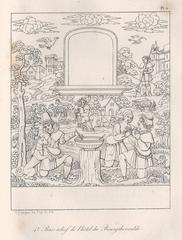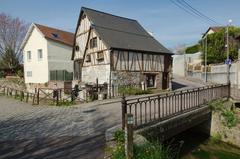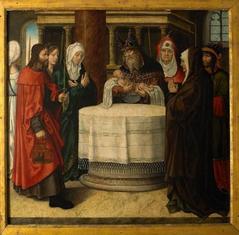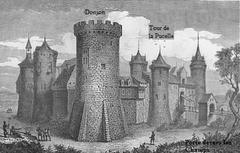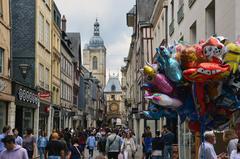
The Great Seaport of Rouen: Visiting Hours, Tickets, and Historical Sites Guide
Date: 04/07/2025
Introduction: The Great Seaport of Rouen
Nestled on the banks of the Seine River in Normandy, the Great Seaport of Rouen is a dynamic intersection of history, commerce, and culture. With roots extending to Roman times, this port has shaped the fortunes of Rouen and Normandy for over two millennia. Today, it stands as an essential economic hub, a focal point for cultural events, and a gateway for travelers exploring the region’s rich heritage. This guide provides detailed information on visiting hours, ticketing, accessibility, top attractions, and practical tips to ensure a memorable visit to Rouen’s historic seaport.
(France Pocket Guide; about-france.com; CruiseMapper; haropaport.com; About2Cruise)
Table of Contents
- Historical Evolution and Significance
- The Modern Port: Economic and Environmental Impact
- Visiting Rouen’s Seaport: Hours, Tickets, and Accessibility
- Top Historical and Cultural Sites Near the Port
- Maritime Events and The Armada de Rouen
- Practical Visitor Tips
- Frequently Asked Questions (FAQ)
- Conclusion and Final Recommendations
- References
Historical Evolution and Significance
Ancient to Medieval Development
Rouen’s origins can be traced to its establishment as the Roman settlement of Rotomagus, a vital trading post connecting inland Gaul to the English Channel. By the Middle Ages, Rouen had emerged as the capital of the Duchy of Normandy and one of Europe’s wealthiest cities, its prosperity built on the bustling river port and robust trade networks. The Gothic Notre-Dame Cathedral, half-timbered houses, and winding medieval streets are enduring testaments to this era’s affluence (about-france.com; nomads-travel-guide.com).
Renaissance to Modern Era
The Renaissance brought artistic and economic flourishing, with the port facilitating exploration and global commerce. Rouen’s port played roles in iconic moments, such as shipping the Statue of Liberty to New York in 1885 (haropaport.com). While Le Havre’s rise in the 19th century shifted much maritime traffic, Rouen adapted, specializing as a leading grain exporter and strengthening connections to Paris and northern France (CruiseMapper).
Twentieth Century and Urban Renewal
Rouen suffered significant destruction during World War II, which led to modern reconstruction and urban transformation. The city has since prioritized heritage preservation, with pedestrian zones and protected historic districts ensuring the charm of its medieval heart endures. Today, Rouen is recognized as a “City of Art and History” and continues to attract visitors with its vibrant blend of old and new (springer.com).
The Modern Port: Economic and Environmental Impact
The Port of Rouen is a vital node in the HAROPA port complex (Le Havre, Rouen, Paris), one of Europe’s largest. It leads continental grain exports, manages over 7 million tons of cereals annually, and serves as a key logistics hub for agricultural, petroleum, and container traffic (AIVP). Its facilities accommodate ocean-going vessels up to 260 meters long and connect seamlessly with road, rail, and river networks.
The port is committed to sustainable development, with initiatives like shore-power installations for cruise ships, water quality monitoring, and the promotion of clean energy and transport. These efforts support both the environment and the quality of life for local communities (AIVP).
Visiting Rouen’s Seaport: Hours, Tickets, and Accessibility
Visiting Hours
- General Port & Riverside Promenades: Public areas, including quays and viewing points, are open year-round during daylight hours (typically 8:00 AM to sunset).
- Maritime Museum (Musée Maritime Fluvial et Portuaire): Open daily from 10:00 AM to 6:00 PM (closed Mondays and some holidays). Confirm seasonal changes on the official site (official museum link).
- Major Events (e.g., Armada de Rouen): Special event areas may have extended hours; verify on event websites.
Tickets
- Public Areas: No tickets required for general access to riverside walks and viewing points.
- Museums and Guided Tours: Musée Maritime charges around €7 for adults, with discounts for children and seniors. Tickets for river cruises and guided tours can be booked online or at the tourist office.
- Armada de Rouen and Special Events: Some exhibitions or ship visits require tickets, available online or on-site during events (CruiseMapper).
Accessibility
- The city center and port quays are pedestrian-friendly, but some cobblestone streets may be challenging.
- Most museums and major attractions are equipped with ramps and elevators.
- The Astuce public transport system offers low-floor vehicles and accessible stops.
- Contact the Rouen tourist office for tailored information about accessible routes and services (normandielovers.fr).
Top Historical and Cultural Sites Near the Port
- Rouen Cathedral: Open daily (8:00 AM–6:30 PM); free entry; renowned for its Gothic architecture and Monet’s series of paintings (SoloSophie).
- Gros Horloge: The 14th-century astronomical clock and one of Rouen’s iconic landmarks.
- Joan of Arc Sites: Trace Joan’s final days at the Church of Saint Joan of Arc and Place du Vieux-Marché (Visite Rouen).
- Musée Maritime Fluvial et Portuaire: Discover Rouen’s maritime history through artifacts, ship models, and interactive exhibits.
- Quays and Riverside Walks: Stroll or cycle along the Seine from the Corneille Bridge to the Rollet Peninsula, enjoying public art, gardens, and riverside cafés (France Guide).
Maritime Events and The Armada de Rouen
Rouen’s port is the stage for major maritime festivals, especially the Armada de Rouen—a spectacular gathering of tall ships and naval vessels. The festival features ship parades, concerts, fireworks, and open-deck tours, drawing millions of visitors. Tickets for special activities and exhibitions are sold online and at event venues; advance booking is recommended (CruiseMapper).
Practical Visitor Tips
Getting There
- By Train: Direct trains from Paris Saint-Lazare (about 1 hour 20 minutes) to Rouen Rive Droite station; the city and port are walkable from the station (bestthingstodoin.city).
- By Car: Well-connected via A13 motorway; central parking is available, but historic core is mostly pedestrian.
- Public Transport: The Astuce network (metro, buses, TEOR) links the city center, train station, and port.
When to Visit
- Best Season: Late spring to early autumn (May–September) for mild weather and festivals. Spring and autumn offer fewer crowds (HikersBay).
- Festivals: Plan ahead for Armada de Rouen and Joan of Arc celebrations, as the city fills up quickly.
Accommodation & Dining
- Wide range of hotels, rentals, and boutique stays near the port and city center.
- Over 600 restaurants in Rouen, with local specialties including seafood, cider, and cheeses (lifeinruralfrance.com).
Safety & Accessibility
- Rouen is generally safe; standard precautions apply.
- Most key museums and sites are accessible; contact the tourism office for specific needs.
Passes & Discounts
- The Rouen Pass offers discounted/free entry to museums and attractions, plus public transport benefits (normandielovers.fr).
Frequently Asked Questions (FAQ)
Q: What are the visiting hours of the Great Seaport of Rouen?
A: Public areas are accessible from 8:00 AM until sunset. Museums and events have individual opening times—check official sources for details.
Q: Do I need tickets to visit the port or maritime museum?
A: No tickets for general quays; museum and event tickets can be booked online or on-site.
Q: Is Rouen’s port area accessible for people with reduced mobility?
A: Yes, most museums and main quays are accessible. The Astuce transport network is mobility-friendly.
Q: When is the best time to visit the port and avoid crowds?
A: Spring and autumn for fewer visitors; summer for festivals and river cruises.
Q: Are guided tours available?
A: Yes, guided walking tours and river cruises can be booked through the tourist office or online.
Conclusion and Final Recommendations
The Great Seaport of Rouen stands as a living testament to Normandy’s maritime legacy and ongoing vitality. From ancient Roman roots and medieval prosperity to its modern role in European commerce, Rouen’s port offers a rich tapestry of experiences for every visitor. With accessible public areas, world-class museums, vibrant quays, and unforgettable events like the Armada de Rouen, the seaport is both a cultural landmark and a vibrant part of city life.
To make the most of your trip:
- Check visiting hours and book tickets in advance for popular attractions.
- Use public transport or walk to explore the pedestrian-friendly city center.
- Download the Audiala app for offline maps, ticketing, and guided tours.
- Follow official tourism channels for updates and insider tips.
Start your Rouen adventure today and immerse yourself in the enduring magic of this historic seaport!
References
- About France
- AIVP
- CruiseMapper
- France Guide
- France Pocket Guide
- HAROPA Port
- Normandie Lovers
- SoloSophie
- About2Cruise
- Visite Rouen

